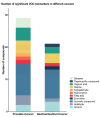Urinary Volatile Organic Compound Analysis for the Diagnosis of Cancer: A Systematic Literature Review and Quality Assessment
- PMID: 33383923
- PMCID: PMC7824454
- DOI: 10.3390/metabo11010017
Urinary Volatile Organic Compound Analysis for the Diagnosis of Cancer: A Systematic Literature Review and Quality Assessment
Abstract
The analysis of urinary volatile organic compounds (VOCs) is a promising field of research with the potential to discover new biomarkers for cancer early detection. This systematic review aims to summarise the published literature concerning cancer-associated urinary VOCs. A systematic online literature search was conducted to identify studies reporting urinary VOC biomarkers of cancers in accordance with the recommendations of the Cochrane Library and Meta-analysis of Observational Studies in Epidemiology (MOOSE) guidelines. Thirteen studies comprising 1266 participants in total were included in the review. Studies reported urinary VOC profiles of five cancer subtypes: prostate cancer, gastrointestinal cancer, leukaemia/lymphoma, lung cancer, and bladder cancer. Forty-eight urinary VOCs belonging to eleven chemical classes were identified with high diagnostic performance. VOC profiles were distinctive for each cancer type with limited cross-over. The metabolic analysis suggested distinctive phenotypes for prostate and gastrointestinal cancers. The heterogenicity of study design, methodological and reporting quality may have contributed to inconsistencies between studies. Urinary VOC analysis has shown promising performance for non-invasive diagnosis of cancer. However, limitations in study design have resulted in inconsistencies between studies. These limitations are summarised and discussed in order to support future studies.
Keywords: cancer early detection; mass spectrometry; urine; volatile organic compounds.
Conflict of interest statement
The authors declare no conflict of interest.
Figures




References
-
- Kumar S., Huang J., Abbassi-Ghadi N., Mackenzie H.A., Veselkov K.A., Hoare J.M., Lovat L.B., Španěl P., Smith D., Hanna G.B. Mass Spectrometric Analysis of Exhaled Breath for the Identification of Volatile Organic Compound Biomarkers in Esophageal and Gastric Adenocarcinoma. Ann. Surg. 2015;262:981–990. doi: 10.1097/SLA.0000000000001101. - DOI - PubMed
Publication types
Grants and funding
LinkOut - more resources
Full Text Sources

